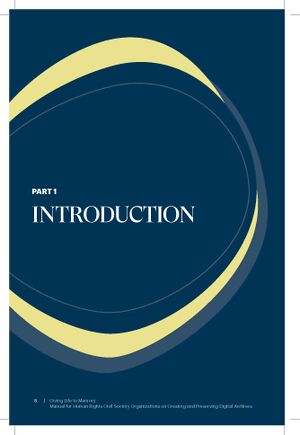Introduction

“It is all there. All the documents have been in that big suitcase in my basement for the past 30 years—the letters, petitions, photographs, press clippings... They could help explain what actually happened back then and how.“ — a friend, a human rights activist, told us recently.
And yet, we all agreed that as long as those documents stay in that suitcase, they are virtually nowhere in that basement. They are not helping explain or teaching our, or other societies, any of the many things they could. Moreover, they are in grave danger of being lost as they degrade over time.
Many of you reading this will have encountered such suitcases—or perhaps card boxes or overcrowded shelves—filled with invaluable historical material about events, crimes, victims, legal processes, or the broader context of human rights abuses committed during an armed conflict or a violent regime rule. Or perhaps you might have stumbled upon a box of hard drives or stacks of DVDs, with seemingly innumerable digital files with witness statements or audio-visual recordings testifying to police brutality and citizens’ protests.
That kind of material is of immense social and historical value, and when faced with it—say, a statement of a survivor of a mass execution or a letter of a husband to his wife from a concentration camp or a scarf made by a mother for her disappeared son—no reasonable citizen, let alone a human rights activist, could allow it to be lost and forgotten. Our core values, our very instinct, all our training, and our experience scream at us that such invaluable evidence, such pieces of history, must be preserved—as well as made public—for the current and future generations of citizens dealing with the legacy of violence from their country’s past.
Many of you understand very well the value of such material, as you might have used it to help victims realize their right to reparation, identify crime perpetrators and bring them to justice, or support truth-telling, memorialization, or education about the violent past. What comes along with such experience is the understanding that it is not sufficient to merely possess certain documents or material, no matter how valuable their content is.

For such material to be utilized for any of the noble causes of human rights defending or for transitional justice, we need to know exactly what it contains, structure and describe it, identify each item within it, define its relationship with other items or groups, and store it in a way that will allow us, and others, to find it again later and be able to retrieve and use it safely.
In other words, we need to create an archive.
But this archive should also be easily searchable, with simple access to each item and its description. The public should have access to nonsensitive material and be able to copy, analyze, and reuse it for legal, educational, artistic, or other purposes. The archive’s contents should be safely preserved, possibly for the long term. At the same time, backup copies should be created, and the entire content should be stored safely, possibly moving it elsewhere if needed.
In other words, we need to create a digital archive.
Put plainly, unless the gathered records of crimes and human rights abuses (physical and digital alike) are preserved in a planned, organized, and sustainable digital form and system, their immediate usability will be very limited – and in the long term they are unlikely to be preserved, let alone leveraged to fully serve their purpose in the future. This is why the need for digital archiving goes to the very core of the hard, painstaking work of numerous organizations worldwide that record and safeguard material on human rights violations.
And this is why this manual was created: to guide the Civil Society Organizations (CSOs) through this process and assist them in creating and developing their own digital archives.